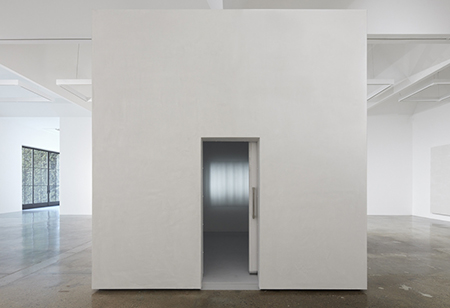
Two immersive installations opened this fall in Los Angeles that share something in common: refrigeration. Mary Corse's "The Cold Room," which was conceived in 1967 and shown for the first time in her exhibition at Kayne Griffin Corcoran; and Adrián Villar Rojas' "The Theater of Disappearance,” currently on view at The Geffen Contemporary. In Corse's installation, viewers enter a refrigerated room to view one of the artist's characteristic suspended light boxes. Villar Rojas' environment is a darkened space in which are scattered three components: boulders, concrete pillars and custom-made refrigerated display cases housing a variety of organic and inorganic materials.
In “The Cold Room" refrigeration serves to enhance our sensory experience. In “The Theater of Disappearance" it functions more as a tool than as an aesthetic end. Additionally, while it is intended to contribute metaphoric value to the installation's content, any clarity or potential poetry gets lost in what descends into a confusing and underwhelming encounter.
Corse's installation succeeds in part because of its minimalist structure. A cubic 12 x 12 x 12 foot chamber is painted white inside and out. "The Cold Room" is a sparse space that viewers enter by opening a door and then closing it once inside. Free from distractions, we are able to engage one-on-one with the light box in the same way we might find ourselves in communion with a religious icon, a sculptural Buddha in a shrine, or a Barnett Newman zip painting. What sets Corse's installation apart from the other altar formats is that our experience in "The Cold Room" is synaesthetic. Not only do we feel the coldness of the chamber's 40 degree temperature, but we hear the pulsating sounds of the light box. Through the combination of a downward shift in temperature, the glowing illumination of argon light tubes, and a soft humming of equipment, a unique state of Zen-like consciousness is attainable.
By contrast, Villar Rojas' The "Theater of Disappearance" is disorienting, and refrigeration plays a subordinate rather than central role in the structure and mechanics of the environment. Before entering the space, we are informed by attendants that we will be in darkness, and that our eyes should be allowed to adjust before proceeding with caution. We are encouraged to use cell phones as flashlights or flash cameras as we move about and explore. Unfortunately, what we find is an unimaginative maze of concrete pillars that suggest stacks of decaying books. Detritus is stuffed into crevices in their surfaces, numerous boulders, and the refrigerated cases containing still life assemblages made from materials such as dead leaves and branches, human and animal bones, and an assortment of utilitarian objects. Although the internal lighting of the cases helps to illuminate their contents and the surrounding space, the fact that they are refrigerated does little to enhance the perception of what we are seeing.
Since there is no introductory wall text, it is unlikely that most visitors would know that Villar Rojas' intent is to make art for the "Anthropocene," a scientific term for our current geological epoch in which human activity is the dominant influence on climate and the environment. Armed with such knowledge, we might then begin to view the refrigeration as functional, in that it prevents the assemblages from deteriorating further. We might also see it as a metaphor for preservation of the environment at large.
A far more successful endeavor towards similar ends was undertaken in 1989-90 by Donald Lipski in his series "Water Lilies," for which he used chemical solutions to preserve fruits, vegetables, and flowers in industrial glass tubing. No refrigeration was needed and, as metaphors for the fragility of nature, these sculptures are particularly enthralling and poignant because the encased objects appear delicate and pristine.
There are also significant precedents by artists who have used refrigeration as a functional or metaphoric tool to great effect. Three coincidentally occurred in 1991. For his debut installation at New York's Barbara Gladstone Gallery, Matthew Barney created "In Transexualis." One section of a fantasy narrative involving acts of endurance, this walk-in refrigerated room housed a weightlifter's bench coated in petroleum jelly, the thick consistency of which with was preserved by the reduced temperature. The work instilled in visitors an otherworldly sensation that suited the narrative. In Buzz Spector's "Cold Fashioned Room" at Pittsburgh's Mattress Factory, the cold temperature of a refrigerated room resembling a Victorian era library brilliantly supported the work's content, increasing the feeling among visitors that they had time-traveled to a bygone era. Also in 1991, British artist Marc Quinn began his haunting ongoing series of sculptural self-portraits made of his own frozen blood, which require refrigerated display cases to survive. Like Lipksi's "Water Lilies," these too remind us that all living things are fragile, temporary and precious.
